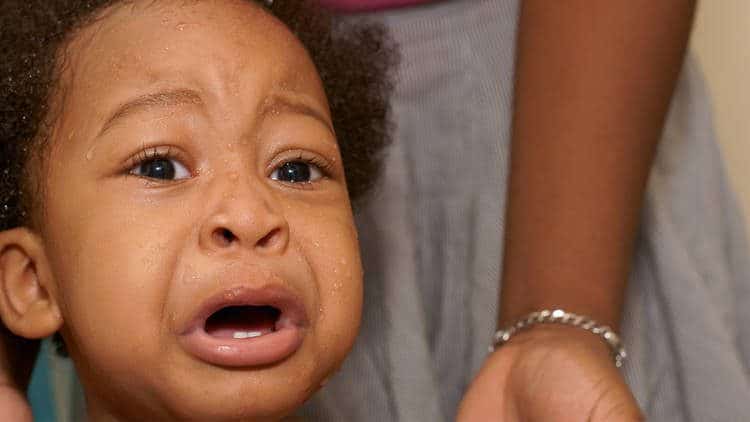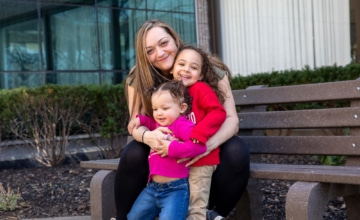Toddlers are delightful people—funny, clever, passionate, eager, curious, and focused on their goals. Browse the information and links below to see what your little one is experiencing and learning this month.
What It’s Like for You
Lakita, mother of Deshawn (20 months), says that the “terrible two’s” came a little early for her son:
It seems like one day he was his adorable little self. The next day he was throwing himself down on the floor of the mall because I wouldn’t let him get an ice cream. My mother was with me and we just looked at each other like, who is this little boy and where is Deshawn?
You’ve no doubt heard of the “terrible two’s.” But as the story above makes clear, breakdowns (aka tantrums) often rear their ugly heads before age 2. But have no fear, these events that most of us dread are actually opportunities for teaching your child important skills, making this period not so “terrible” at all.
Toddlers are delightful people—funny, clever, passionate, eager, curious, and focused on their goals. (And at this age and stage, their happiness or sadness is dependent on getting what they want…though this doesn’t mean that giving in is a good idea. Learning how to cope with life’s disappointment and frustration is very important. Further, this ability to cope is likely to lead to greater satisfaction and happiness as they grow.) It’s all these great qualities—combined with very limited self-control and language skills that don’t allow them to say what they need—that can make these months challenging. So how do you handle a tantrum with a child who doesn’t yet understand logic and who has very limited ability for self-control? Take a deep breath. Stay calm. Set clear, fair, age-appropriate limits. Be firm, not angry. Offer love and comfort to help your child recover. Take another deep breath. Remember that you still have almost 11 years before they’re teenagers.
What It’s Like for Baby
Arms up! I work hard to follow your directions when you help me get dressed in the morning. Thanks for being gentle and making sure that the shirt doesn’t catch on my ears or nose. I hate that! I know that sometimes I pull away and say, Me do it! When you let me try, you will see how much I’ve learned from you. I can help push my head through the hole of the shirt and poke my arms through the openings where they go. I stick my foot into the sock, but get a little frustrated when I can’t figure out how it goes in. When you help me just enough so I can do it, and then tell me how proud you are that I am getting to be such a big kid, I feel so good and strong.
I know I can also be a little wiggle worm sometimes, but it’s hard to be patient when I think about my toys waiting for me in the other room. It helps when you make getting dressed fun, like counting my toes as we put on my socks or pretending that my pants go on my head. I say No, silly! and we laugh. We name the colors of my clothes—red, blue, yellow, green. You even let me choose which shirt I want to wear sometimes. When we’re done, you give me a big hug and tell me how cute I am. Then I try to help you get dressed just like you helped me. I hold your sock up to your foot and push it over your toes. You tell me I’m a good helper. That makes me happy so I give you a big hug.
What Your Toddler Is Learning
Social-Emotional Skills:
- Self-confidence, when he is given an important choice to make (about what shirt to wear). Self-help tasks, like dressing, also help children feel confident about their own abilities.
- Cooperation and following directions, when he listens to his mother’s instructions while getting dressed
- Coping with frustration, as he works to put on socks
- Patience and learning to wait, both important for learning self-control, when he has to leave his toys to get dressed
- Sense of humor, when his mother makes a joke about wearing pants on his head
- Helpfulness, when he tries to help his mom put on her socks
Language and Thinking Skills:
- How to use language in a playful way—as when his mother jokes about putting pants on his head
- Words for colors and numbers
- Spatial relations—how pieces fit together, like getting his head through the head hole of his shirt
- Problem-solving—as in how to get his socks to fit over his feet
- Understanding the sequence of events (getting dressed before breakfast; putting a diaper on before pants)
Physical Skills:
- Fine motor skills (using the small muscles in his hands and fingers) that he uses to hold his sock and shirt to get them on
What to Expect From Your Baby’s Development
As you review the chart, keep in mind that development is not a race and that every child grows at her own pace and in her own way. Your child may develop skills faster or slower than indicated below and still be on track. If you have questions or concerns, talk with your child’s health care provider or other trusted professional.
Your Toddler’s Development From 18 to 24 Months
| What Your Baby Can Do | What You Can Do to Connect With Your Baby |
|---|---|
I am learning new words everyday. |
|
|
|
I can use my hands and fingers to do so many new things. |
|
|
|
I am learning about my own and others’ feelings. |
|
|
|
I am beginning to use my imagination. |
|
|
|
I am a little scientist, always testing things out! |
|
|
|
Did you know…
That talking with your 20-month-old about experiences she’s had helps her remember these moments better, sometimes months, and up to a year, later? Toddlers at different ages (13, 16, and 20 months) were tested for their memory of activities that happened during a visit to a researchers’ lab. The memory test occurred at different time periods, ranging anywhere from 1 to 12 months after the lab visit. The study found that when parents talked about the lab visit with their children, it seemed to help them remember the event. Neither the age of the child at the time of the lab visit nor how much time had passed since the visit made a difference. Their memories were demonstrated both nonverbally and verbally.
What the Research Means for You
Children learn from you, their first—and best—teacher. When you take the time to talk with your toddler about his life experiences, he remembers them better and also learns more about the world around him. Repetition at this age helps children master new ideas and new skills. That’s why your toddler likes to hear the same story over and over or play the same game again and again. What can you do to nurture your child’s learning and memory?
- Tell the story of your child’s day. At bedtime, take a few minutes to talk about what your child did that day—how he felt, what he saw, where he went. (If your child is at child care during the day, talk to his teacher about the day’s activities.) This helps your child remember his experiences and make sense of what happened that day (the events and how he felt).
- Tell the story of what will happen. Before important experiences in your child’s life—a trip to the doctor, a visit to the grandparents—tell her what will happen, what she will do, and why she is doing it. This gives your child a chance to look forward to fun activities, and to prepare for events that may be difficult (like a trip to the doctor).
- Add some pictures. Create simple photo books of your child’s everyday experiences (such as pictures of his morning routine: eating breakfast, brushing teeth, putting on his shoes). This can be a lot of fun for your toddler because he can “tell” you the story himself using the pictures and his memory. Making photo books of special days—like a birthday party—is also a great way for your child to remember these important times. And the books don’t have to be fancy! Books made of photos glued onto index cards (with your notes on the bottom) are just perfect.
- Let your child talk about scary or upsetting experiences. Sometimes, when a child has had a scary experience, we might encourage her to move on and not talk about it. We might worry that if she talks about this fearful experience, like a dog barking and running at her, that she will get more scared. But ignoring feelings doesn’t make them go away. In fact, they can linger and have a negative impact on the child. Encouraging your child to talk through a frightening moment, while you help her make sense of it and reassure her, actually helps your child move on from the experience faster.
Spotlight On: Setting Limits With Young Toddlers
Toddlers have minds of their own and strong feelings that they express with gusto. While they are funny and thoughtful, curious and passionate, there are some very typical challenges that come with having a curious, active toddler. For example, No! becomes a favorite word and a powerful way for toddlers to assert their independence. Toddlers can also become easily frustrated because there are still many things that they want to do but can’t yet. Often, they do not have the communication skills to explain, express, and fully make sense of these strong emotions. At the same time, toddlers can move in lots of new ways, allowing them to get to whatever they want to explore. While this is really exciting, it also leads to challenges as young toddlers do not yet have the self-control to stop themselves from touching what you’ve said not to or going where it’s off-limits.
Young toddlers have difficulty controlling their behavior during this period because they are not yet able to:
- Fully understand the consequences, or the cause and effect, of their actions
- Understand the difference between acceptable and unacceptable behavior
- Remember the limits or rules you set without your having to tell her
- Have the self-control to stop themselves from repeating an unacceptable behavior
This is why punishment is not effective for young toddlers. In fact, punishments can be scary and confusing for children. However, it is still important to begin setting limits on your toddler’s behavior, both to keep her safe and to help her eventually understand the consequences of her actions and how to make good choices as she grows.
The first step in limit-setting is getting in a positive mindset. Your child is not purposefully being “bad”. He is simply trying out different behaviors to see what happens. Your response helps him learn what behaviors work best. Your toddler’s most challenging moments—when he wants a cookie before dinner, to climb the stairs by himself, pull on your earrings, knock a block against the window, you name it—are also the best moments to help your child learn to manage his anger, sadness, and disappointment, and to teach him what is and is not acceptable.
With this frame of mind, the steps below can help you effectively set limits (while knowing that you will probably set this limit a thousand more times before your child “gets” it):
- Use words and actions to limit-set. Words alone are often not enough to get your toddler to stop an unacceptable activity. Use a low, firm (not angry or screaming) voice. At the same time, use a “stop” or “no-no” gesture along with your words. Young toddlers communicate primarily through actions so it helps to use both words and gestures when you are setting limits.
Keep in mind that your toddler may not respond the first or even the second time you set a limit. It takes hundreds of repetitions—hearing the words together with the actions—before the words alone are enough.
- Acknowledge your child’s goal and then redirect her to acceptable activities. Use words to show your child that you understand what she wants to do: I see that you want to play with the water. But you cannot spill it from your sippy cup onto the floor. Let’s go outside and play with water there. Or, It’s not okay to throw blocks. Someone might get hurt. You can throw these foam balls in the basket instead.
If you stop your child’s behavior, but do not offer an alternative, the unacceptable behavior is more likely to continue. This is because most young toddlers are not yet able to come up with other (more acceptable) activities on their own. And don’t forget to give your child lots of positive feedback when she does the “right” thing (i.e., petting the kitty gently), rather than emphasizing what your child should not do (pull the kitty’s tail).
Let’s Play: Activities That Nurture Bonding and Learning
Freeze!
Put on some music and dance with your little one. Every few minutes, switch the music off and say Freeze. Teach your child how to stand in place. Then play the music again. Games like this teach listening skills, self-control, and build balance and muscle coordination.
Recycle Ball
Place a cardboard box or recycling bin against a wall. With your child, make balls of newspaper. Show your child how to throw the newspaper into the box. Practice standing very close, then take small steps farther and farther away. You can also use your imaginations and drive toy dump trucks, filled with newspaper balls, to the recycling bin.
What’s on Your Mind?
1. How do I wean my 20-month-old daughter off her pacifier? She goes to sleep with it and uses it to calm herself down when she’s upset.
First, consider why you want to wean your child from the pacifier. If it’s interfering with her ability to interact, talk, or play with others, then it may be a good idea to phase it out. But if she is using it only to fall asleep and to soothe herself, then she’s using it wisely and there is no need to give it up right now.
Like many parents, you may be concerned about the impact of pacifier use on your child’s teeth, but this is not a concern at her age. Pediatric orthodontists report that regular use of a pacifier before age 4 does not cause dental problems. Other parents are embarrassed by seeing an older baby with a pacifier. But when your child gets to preschool and sees that the other kids don’t use one she’ll likely give it up on her own. It is true, however, that the longer a habit goes on, the harder it can be to break, which is a reason to consider starting the weaning process sooner rather than later.
Since your child is using her pacifier to self-soothe, an important first step to weaning is to help her find other ways to calm herself. Many children use a security toy for comfort. If your daughter doesn’t have a “lovey” already, you can help her develop one by choosing a blanket, stuffed animal, or doll, and including it in your caretaking activities. Have it sit on your daughter’s lap as you read together, and set it next to her as she eats and when you cuddle before bedtime.
For some children, taking the pacifier away gradually may be best. When your child wants the pacifier during the day, let her have it for a minute or two and then offer other ways to help her calm down—a hug from you, snuggling with her lovey, or reading a book together. Or, establish some rules about when she is allowed to use the pacifier, such as only during naps and at bedtime. Reduce the time you let her have it until she doesn’t use it at all. Taking the pacifier away at bedtime will probably be more difficult. Perhaps let her use it during reading time but not when she goes to sleep.
For other children, such as those who need more predictability and have a hard time with change, it may be easiest to go cold turkey. Some families have a ritual during which they gather up all the pacifiers and put them in a special memory box that gets tucked away somewhere. Other families collect the pacifiers and put them in an envelope that they place in the mailbox to “send the pacifiers to another baby who needs them.”
2. My 20-month-old has an incredibly close and loving relationship with her babysitter. But beginning in a few months, my daughter will be starting at a child care center that is closer to my work. How can I prepare for and explain this huge change to my child?
Your daughter is fortunate to have a parent who is sensitive to the challenge of this transition and is thinking about how to help her cope. The good news is there is a lot you can do to make it as smooth as possible for your child. Here are some ideas:
- Talk with her about the change. About 2 weeks before the transition, tell your child that during the daytime she will be going to a child care center; that she is big enough now to go to a really fun place to play with other children all day. Explain how, after she starts going to child care, her babysitter will still call and visit her (talk to your sitter beforehand to see if she would be willing to do this). Keep in mind that, even though your daughter will not fully understand the meaning of what you are saying, it is still important to have this talk. And be sure to recognize whatever feelings she expresses verbally and nonverbally. Be upbeat and positive about the change as young children pick up on your cues. If you act upset and worried about the move to child care, your daughter is more likely to be worried too.
- Visit the center as often as you can over the next 2 weeks. The familiar is less frightening. Spend time in the classroom so she can meet her teachers and see what goes on there. Let her explore both inside the classroom and on the playground.
- Say cheese. Take some photos of your daughter and her caregiver over the next few weeks and months. Put them together in a special album for your daughter. If she misses her caregiver after she starts at the center, she can look back at the memory book you’ve made.
- Think about a gradual transition. See if it is possible for your daughter to do a half-day at child care and a half-day with her babysitter for the first week. Making the transition in this way may be easier for your daughter.
- Trust yourself—and your child. While your daughter may protest this change in the short-term, and may understandably be sad and angry, with love and support from you and her new caregivers she will successfully make the transition. And mastering this challenge will help her feel confident to cope with future changes. She will also have the experience of building relationships with new adults and children that will broaden and enrich her world.
Expert Reviewers
- Terrie Rose, PhD, President and Founder, Baby’s Space
- Ross Thompson, PhD, Professor of Psychology, University of California at Davis
- Robert Weigand, MS, IMH-E, Director, Child Development Laboratory, Arizona State University
This ZERO TO THREE newsletter series was made possible by generous funding from the MetLife Foundation.
*Additional reporting by Claire Lerner





